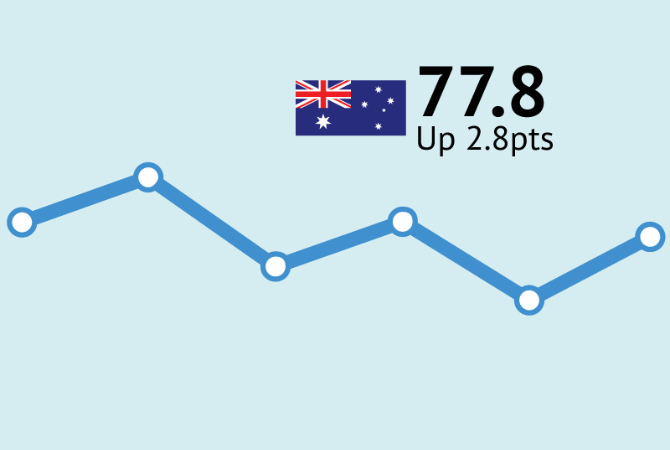ANZ-Roy Morgan Consumer Confidence up 2.8pts to 77.8 – with more people saying it’s a ‘good time to buy major household items’

ANZ-Roy Morgan Consumer Confidence increased 2.8pts to 77.8 this week but has now spent a record 40 straight weeks below the mark of 85. Consumer Confidence is now 0.9pts below the same week a year ago, October 31 – November 6, 2022 (78.7) and is now just above the 2023 weekly average of 78.1.
Looking around the States Consumer Confidence was up in NSW, Victoria, Queensland and South Australia, but down slightly against the trend in Western Australia.
Driving this week’s increase was far more positive buying sentiment with more people saying now is a ‘good time to buy major household items’ and fewer saying it’s a ‘bad time to buy’.
Current financial conditions
- Now a fifth of Australians, 20% (up 3ppts) say their families are ‘better off’ financially than this time last year compared to a slim majority of 52% (down 4ppts) that say their families are ‘worse off’.
Future financial conditions
- Looking forward, under a third of Australians, 28% (down 1ppt), expect their family to be ‘better off’ financially this time next year while 37% (unchanged), expect to be ‘worse off’.
Current economic conditions
- Only 6% (unchanged) of Australians expect ‘good times’ for the Australian economy over the next twelve months compared to over one-third, 38% (down 2ppts), that expect ‘bad times’.
Future economic conditions
- Net sentiment regarding the Australian economy in the longer term is unchanged this week with 11% (unchanged) of Australians expecting ‘good times’ for the economy over the next five years compared to a fifth, 20% (up 1ppt), expecting ‘bad times’.
Time to buy a major household item
- There is good news for retailers this week with sentiment regarding buying intentions improving markedly. Now 22% (up 4ppts) of Australians, who say it is a ‘good time to buy’ major household items (the highest figure for this indicator for nine months since early February) as we enter the Christmas retailing period while a slim majority of 51% (down 3ppts), say now is a ‘bad time to buy’.
ANZ Senior Economist, Adelaide Timbrell, commented:

The ANZ-Roy Morgan Australian Consumer Confidence index increased last week despite an expected cash rate hike at the November RBA board meeting. The four-week average for consumer confidence is at its weakest since late August. Household inflation expectations rose to 5.5% with petrol prices stuck at an elevated level, though overall inflation expectations seem to remain anchored. Confidence is still stuck at very weak levels as high inflation and increased interest payments erode households’ ability to save and spend. Confidence is still lowest among those paying off their homes, and the gap slightly widened this week as renter and outright owner confidence rose, while confidence among those paying off their homes fell.

Check out the latest results for our weekly surveys on Business Confidence, Consumer Confidence, and Voting Intention as follows:
Roy Morgan Business Confidence Statistics
ANZ – Roy Morgan Consumer Confidence Statistics
Federal Voting – Government Confidence Rating
Related Research Reports
The latest Roy Morgan Consumer Confidence Monthly Report is available on the Roy Morgan Online Store. It provides demographic breakdowns for Age, Sex, State, Region (Capital Cities/ Country), Generations, Lifecycle, Socio-Economic Scale, Work Status, Occupation, Home Ownership, Voting Intention, Roy Morgan Value Segments and more
Consumer Confidence – Monthly Detailed Report in Australia.
Business Confidence – Monthly Detailed Report in Australia.
Consumer Banking Satisfaction - Monthly Report in Australia.
For comments or more information please contact:
Roy Morgan - Enquiries
Office: +61 (03) 9224 5309
askroymorgan@roymorgan.com
Margin of Error
The margin of error to be allowed for in any estimate depends mainly on the number of interviews on which it is based. Margin of error gives indications of the likely range within which estimates would be 95% likely to fall, expressed as the number of percentage points above or below the actual estimate. Allowance for design effects (such as stratification and weighting) should be made as appropriate.
| Sample Size | Percentage Estimate |
| 40% – 60% | 25% or 75% | 10% or 90% | 5% or 95% | |
| 1,000 | ±3.0 | ±2.7 | ±1.9 | ±1.3 |
| 5,000 | ±1.4 | ±1.2 | ±0.8 | ±0.6 |
| 7,500 | ±1.1 | ±1.0 | ±0.7 | ±0.5 |
| 10,000 | ±1.0 | ±0.9 | ±0.6 | ±0.4 |
| 20,000 | ±0.7 | ±0.6 | ±0.4 | ±0.3 |
| 50,000 | ±0.4 | ±0.4 | ±0.3 | ±0.2 |





